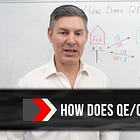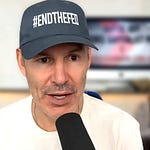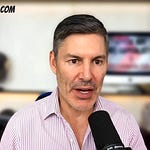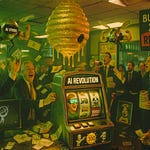Back in September 2019, we got a glimpse of just how brittle the financial plumbing can be. The repo market…a corner of finance most people don’t pay attention to…broke. Overnight lending rates spiked to over 10%, and everyone from Wall Street veterans to Federal Reserve officials was scrambling to make sense of it.
Fast forward to October 2025, and the repo market is flashing red again.
But this time, the warning signs are subtler and more insidious.
Instead of an overnight explosion, we’re seeing slow-burn dysfunction: a growing spread between SOFR (Secured Overnight Financing Rate) and the effective federal funds rate, even outside of typical month-end volatility.
And no one’s quite sure why.
The establishment media, predictably, is asleep at the wheel…parroting the same tired explanation: “liquidity shortage.”
But is it really about liquidity? Or is something more fundamental…and dangerous…unfolding beneath the surface?
Let’s connect the dots.
The SOFR Spread Spike: A Canary in the Coal Mine
Typically, when we talk about repo spikes, we expect them to appear around month-end. That’s when balance sheet pressures mount due to regulatory constraints, banks pare back lending temporarily, and rates spike. It’s noisy, but explainable.
But what we’re seeing now isn’t that. A significant spike in the SOFR spread occurred mid-month, outside any typical reporting period. There was no obvious catalyst…no quarter-end, no balance sheet rebalancing, not even a major Fed announcement. It was just… there.
So, what’s going on?
The mainstream explanation is simple: not enough cash in the system.
The Fed has been tightening for over two years now, shrinking its balance sheet, rolling off Treasuries and MBS.
QT has drained bank reserves, we’re told, and the market is “running out of money.”
Enter the calls for QE, the belief that more reserves = more lending.
But that story doesn’t hold up under scrutiny.
Banks don’t lend out reserves. They don’t even need them to make loans. They lend based on risk-reward expectations. Period.
If they see opportunity, they lend. If they see danger, they pull back. Reserves are just the plumbing…important, but not the faucet.
What’s really happening is that risk in the system is going up. And the repo market is pricing that in.
What if this isn’t just a technical glitch…but the market’s way of whispering, “We don’t trust each other anymore”?
When risk perception quietly shifts from duration to counterparties, it’s not a plumbing issue. It’s the early stages of contagion. And that contagion is already showing up where confidence goes to die…the collateral markets.
Not a Liquidity Crisis…A Confidence Crisis
If banks or money market funds are demanding a higher rate to lend overnight…even for collateralized loans…something’s up.
And that something is counterparty risk.
Remember, repo lending is secured. The borrower posts collateral…typically Treasuries…and gets cash in return. The lender assumes the loan is “safe” because they can always sell the collateral. But what if the collateral isn’t as pristine as it appears?
Enter Zion Bank and Western Alliance. Both institutions recently disclosed large losses tied to commercial real estate loans. The kicker?
The borrowers misrepresented their collateral…pledging the same property to multiple lenders. When defaults hit, everyone thought they were first in line. Turns out, they were fifth or sixth.
This is textbook systemic risk: fraudulent collateral, poor disclosure, and cascading exposures across multiple institutions. And it’s showing up in repo.
When lenders see collateral games being played…even in isolated incidents…they don’t wait for the fire to spread. They charge more. They hoard liquidity. They reassess risk across the board.
That’s not a liquidity issue. That’s a trust issue.
Once trust in collateral breaks down, liquidity isn’t something the Fed can simply print back into existence.
Because the moment a lender asks, “Who really owns this asset?”…the entire façade of safety starts to crack. And those cracks are now spreading into markets most investors think are “unrelated.”
Oil, bonds, and gold are already sending distress signals. Let’s decode what they’re saying.
Collateral Damage: Oil, Bonds, and Gold Agree
The rising SOFR spread isn’t happening in isolation. It’s part of a broader constellation of market signals pointing to systemic fragility.
Look at oil. Crude is trading under $58, having sliced through 12-month support.
This isn’t about oversupply…OPEC could fix that with a press release. This is about collapsing demand expectations.
Energy is the economy, and demand for oil is a real-time barometer of economic health. Falling prices suggest the market is pricing in recession.
Then there’s the bond market. The 10-year Treasury yield has fallen below 4%, and the 2-year yield is under Fed Funds.
That’s not a market afraid of inflation or supply concerns.
That’s a market screaming disinflation, possibly even deflation. It’s also a big vote of no confidence in the Fed’s “higher for longer” narrative.
Meanwhile, gold is ripping to all-time highs. Not because of “debasement”…if that were true, oil would be joining the party.
No, gold is rising because fear is rising. Fear of counterparty risk. Fear of a credit event. Fear of another 2008, but dressed in commercial real estate clothing.
When gold, bonds, and oil all move in the same direction…and it’s not the one the Fed wants…you’d better pay attention.
When every asset class starts echoing the same warning, you’re not looking at coincidence…you’re looking at correlation through fear.
These aren’t market moves…they’re survival instincts.
But the question is, what exactly are they afraid of? The answer hides in the shadows…where the riskiest lending now lives, unseen and unregulated.
Shadow Banking, Hidden Risk, and the Next Domino
Why are these risks emerging now? Aren’t we still in the middle of a “strong and resilient” economy?
Answer: because the tide is going out.
When everything is booming, nobody cares if your collateral is rehypothecated five times. Nobody checks the fine print. Everyone gets paid.
But when growth stalls, rates fall, and demand dries up, people start checking. Suddenly, they realize the collateral isn’t there…or worse, it’s pledged elsewhere.
That’s when fraud is exposed, losses pile up, and liquidity freezes.
And the wildest part? Most of these risky loans aren’t even on bank balance sheets anymore.
Thanks to post-GFC regulations, banks now lend through shadow entities…NDFIs (Non-Depository Financial Institutions). These outfits operate outside the regulatory perimeter. They borrow from banks or money markets, then lend to the real economy…commercial real estate, auto loans, subprime borrowers.
It’s leverage-on-leverage, hidden in the shadows. And when the tide goes out, it gets ugly.
The big banks are insulated…for now. JP Morgan took a $170 million loss tied to a subprime lender, but that’s a rounding error.
The real concern isn’t the dollar amount…it’s what those losses say about the system.
That’s why Jamie Dimon is talking about cockroaches. If you see one, you know there are more.
The Fed can’t regulate what it can’t see…and the shadow system has become the real system. The moment those off-balance-sheet loans start to implode, “systemic risk” won’t be theoretical anymore. It’ll be contagious. And the cruel irony?
Regulators built this monster while trying to prevent the last one. Which brings us to the final illusion holding the system together: regulation itself.
The Myth of Regulation and the Moral Hazard Loop
This is where the conversation gets uncomfortable.
The central planners will tell you that Basel III, Dodd-Frank, and stress tests have made the system “safe.” But all these rules do is push risk outside the perimeter…into entities that aren’t supervised, don’t have capital requirements, and can’t be bailed out.
And yet the big banks know…if things go sideways, they’ll be rescued. They’ve always been rescued. From LTCM to 2008 to 2020, the Fed has never let them fail.
That’s the real problem.
As long as bailouts are on the table, risk-taking will never stop. Banks will always find ways to skirt regulations…because they’re incentivized to do so.
And when it blows up, the taxpayer will foot the bill. Again.
Every bailout teaches Wall Street the same lesson: take bigger risks, because someone else will eat the losses. That’s not stability…it’s moral hazard in drag.
And like every cycle before, it ends the same way: with investors asking, “Who’s left to save the saviors?” The smart money isn’t waiting for that answer. They’re already preparing for the break.
How to Prepare: Ditch the 60/40 and Think Like a Contrarian
So where does this leave the average investor?
Here’s where it doesn’t leave you: buying SPY and praying. The 60/40 portfolio is a dead man walking in a world of stagflation, disinflation, and systemic risk.
What’s needed is a radically different approach…one that prioritizes capital preservation, asymmetric upside, and optionality.
That means gold, short-term Treasuries, foreign currencies, and select equity positions with a margin of safety.
It also means understanding the plumbing…repo, reserves, collateral…because that’s where the cracks show up first.
The contrarians are already moving. They see what’s happening in repo. They see what’s happening in oil, bonds, and commercial real estate. And they’re adjusting accordingly.
Are you?
The repo market is sending smoke signals again…and this time, the fire may not be containable. If you want to navigate what comes next, you can’t rely on old playbooks or Wall Street narratives. You need to think independently, move early, and understand how the system really works before it breaks.
Join the thousands of contrarian investors on the Rebel Capitalist News Desk for unfiltered macro insights, real-time market breakdowns, and access to George Gammon’s Weekly Wrap-Up Q&A…where you can ask him your own questions about money, markets, and freedom.
Because by the time the Fed admits there’s a problem, it’ll already be too late to act.














